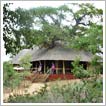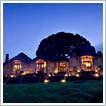
Climb Kilimanjaro FAQ
Here is where you will find answers to some of your questions about this expedition. If you do not find what you need here, please contact us at info@bergadventures.com.
Choose the specific question to link to your answer
- Are Internet dispatches done for all of your Kili climbs?
- Which trip dates occur during the warmer season?
- How cold is it high on Kilimanjaro?
- When is the rainy season?
- Which dates generally have the most people signed up?
- Which kind of gear do I need? Can I rent some of the items?
- What is the usual number of people per tent?
- Is there a community tent for eating/gathering?
- Approximately how much weight will climbers carry?
- Do your guides carry medical oxygen on the Kili climb?
- Do you have guides to take someone back down should they become ill upon ascent and require descent?
- Could you give an example of a typical breakfast, lunch and dinner?
- Should I bring snacks?
- What are the accommodations like on the safari?
- What type of vehicle is used?
- On the climb and on the safari, how is the drinking water situation handled?
- Do you have access to radio communications for any emergency needs if one were to arise?
- Should I bring gifts for local Children?
- What language is spoken in Tanzania?
- Why is the Pofu Route more expensive than the other routes on Kilimanjaro?
- 1. Are Internet dispatches done for all of your Kili climbs?

- They can certainly be done for any of our Kili climbs and safaris at no extra cost. If your group chooses to do one, a phone will be provided along with a dispatch line which you can use to post news of your adventure. We ask only that you remember that these accounts will be read all over the world and are of great interest to people. They will also be permanently archived on the Berg Adventures web site, so you will always have a record of your Tanzanian adventure. The dispatches are intended for you to tell people who are watching about what is going on during your climb. Check one of our dispatches so that you can have an idea of how it works.
- 2. Which trip dates occur during the warmer season?

- This is a good question. Even though it is only about 3 degrees south of the Equator, Northern Tanzania has surprisingly variable temperatures through different times of the year. The locals generally refer to July and August as “winter” and it is the coolest time of the year in Arusha. Night time lows are typically about 48F (9C) and daytime highs are only in the 60's or 70's (16C to 24C). You are probably thinking that these sound like very pleasant temperatures, and you are right. One thing we always tell people is "if you leave North America in the summer months and travel to East Africa you are going to a cooler climate." This is surprising to most people, but very true. Safari and the time you spend in Arusha during these months can be wonderful in terms of weather – never as hot and steamy as you probably imagine tropical Africa to be. Similarly, if you are on a trip during the Northern Hemisphere winter, you will find the weather to be as much influenced by altitude as latitude. It is warmer in December or February, but it is still not extremely humid or hot.
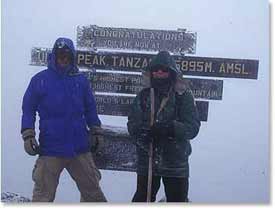 3. How cold is it high on Kilimanjaro?
3. How cold is it high on Kilimanjaro? 
- Well below freezing, perhaps as cold as 10F/-12C. Even if it is much warmer than this your body will feel very cold however. Talk to anyone who has climbed Kilimanjaro, at anytime of the year, and they will probably comment about how cold they got on summit day. This has more to do with the mild hypoxia (lack of oxygen) and the exertion that climbers experience, than it has to do with temperatures, or even wind. When you go to 19,000 feet, (5800 meters) anywhere on the earth, at anytime of year, you need to have very efficient insulation and be prepared to conserve you body's energy effectively.
- 4. When is the rainy season?

- All of our Kilimanjaro climbs avoid the two rainy seasons in Tanzania, the "long rains" in April and May and the "short rains" from late October through November. It is important to understand however that weather on Kilimanjaro is as changeable and unpredictable as mountain weather all over the world. Some light rain is virtually constant in the lower sections of the mountain throughout the year. The upper reaches of Kilimanjaro are generally arid and clear skies are common on our trips. As a rule mornings are clearer than afternoons.
- 5. Which dates generally have the most people signed up?

- The most popular months on Kilimanjaro are July and August, with December running a close third. You will see fewer people from other groups in months other than July, August or December. At BAI we take pride in the fact that we use more isolated and unique campsites on all our routes however. You will have a great trip any time of the year you decide to go with us.
- 6. Which kind of gear do I need? Can I rent some of the items?

- Please check our gear list which should answer many of your questions. We can also rent some gear which you will need on the mountain like sleeping bags, down jackets and other items which are all manufactured in North American by top brands.
- 7. What is the usual number of people per tent?

- We will be using North Face 4 season VE-25 tents. Two people per tent.
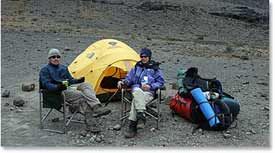
- 8. Is there a community tent for eating/gathering?

- Yes, we have a large dining tent and tables and chairs that are used at all camps.
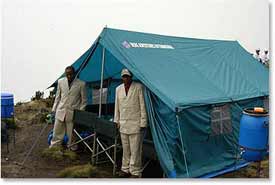
- 9. Approximately how much weight will climbers carry?

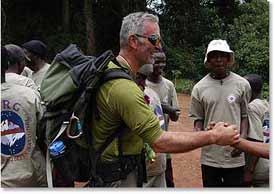
- You will need a medium sized rucksack (2500 to 3500 cubic inches or 40 to 55 litres) that can hold your layers of clothing for changing temperatures and activity levels throughout the day. It is not uncommon to get to camp as the afternoon and evening temperatures cool off, ahead of the porters. You need to be prepared to be inactive through part of each day as well as to hike. Most people carry packs that weigh about 15 pounds (7 kilos). You could pare this down to perhaps 10 pounds (5 kilos) if you were careful, but with a lot of camera equipment, or other personal preference type items, it might be more. In addition to the porters who carry your big bags our guides who are with you throughout the day are always willing to help you carry your day pack at no extra cost. Most people find it much more desirable to keep their own personal items in a day pack they carry themselves, but this is never necessary.
- 10. Do your guides carry medical oxygen on the Kili climb?

- Yes. We carry oxygen on all our climbs. We feel it provides an extra margin of safety on the mountain. We also carry emergency pressure bags called “Gamov Bags” for treatment of serious altitude sickness. Your group will be provided with pulse oximeters and complete emergency kits as radios and cell phones for communication. Our guides are experienced at monitoring the well being of climbers on Kilimanjaro. Serious medical problems on Kilimanjaro are rare, but we will be prepared should the need arise to use our equipment.
- 11. Do you have guides to take someone back down should they become ill upon ascent and require descent?

- We normally take 4 to 5 guides for a summit attempt of 8 BAI climbers. All of these guides are qualified, personable and dedicated. They have done many successful summits together and have worked with BAI for years. They all know how to get people up and down safely and efficiently.
- 12. Could you give an example of a typical breakfast, lunch and dinner?

- Breakfast: scrambled eggs or omelettes, hot cereal/oatmeal, toast, sliced cucumber and tomato, fresh fruit slices, coffee, tea and cocoa (available on every meal).
- Morning Trail Snacks: candy bar, fresh fruits, nuts, and fruit flavoured drinks
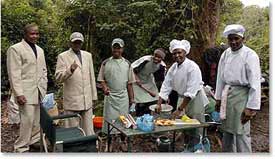
- Lunch: chicken, home made bread, hearty sandwiches, cheese, avocado, salami, fresh fruits, peanut butter and jam, potato chips, trail mix, candy bar, dried fruits, hot tea and fruit flavoured drinks.
- Afternoon Tea: hot drinks, popcorn, cookies.
- Dinner: hot soup (always!), salad, chicken with rice, variety of pasta, steamed / cooked vegetables such as sliced fresh carrots, green beans, mashed potatoes, cake for dessert( baked on the mountain!) and home made cookies.
- Our menus are always improving and we always have new dishes being introduced. We also cater to special dietary needs like vegetarian, gluten free. We can even have birthday cakes during the climb! We always have a chef preparing the meals, not only a cook.
- We stage replenishment of supplies frequently during your trip, with fresh food delivered by our skilled runners.
- 13. Should I bring snacks?

- Take a look at the typical menu lists above and ask yourself, what else will I really want? We find many people bring far too much “emergency” or snack food. If you have special dietary needs, or a particular “Goo” or Powerbar type snack that you prefer, go ahead and bring it along but do not get carried away with the quantities. You will have plenty of high quality, nutritious food, and excellent variety in you menu options every day.
- 14. What are the accommodations like on the safari?

- This is our favourite question. For years we have been telling people "the safari lodges are really nice" and then we watch the astonished looks when people walk into our lodges and exclaim "You didn't tell us it was going to be this nice." We use these places to relax and reward ourselves after a rigorous climb. They really are beautiful in terms of setting and amenities.
- The safari drives have their own demands, long dusty days and a lot of excitement and adventure with all the wildlife. One of the greatest feelings is to go into your room at the end of one of these days, get a shower and some clean clothes on, and go have a nice dinner with your friends with whom you have recently climbed Kilimanjaro. The sun will be setting on the African landscape and the large glass windows will scarcely separate you from this. It is pretty civilized. We do offer upgrades to the very exclusive small safari camps such as Migration Camp in Serengeti. Contact our office to discuss pricing and availability.
- 15. What type of vehicle is used?

- You will be in a Land Cruiser, maximum 6 per vehicle. This is your private safari; there will be no new members of the team joining your safari unless it has been previously arranged by your group. An experienced Guide/Driver will drive your vehicle. He is the only person who ever drives his vehicle and is responsible for its complete safe operation and maintenance for the 2 to 3 years it sees service after it is purchased. Everyone in the back is under a canopy that extends up so that you can stand for wildlife viewing and photography while you are in the parks.
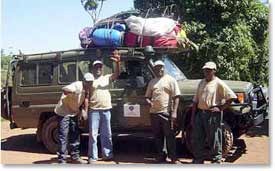
- 16. On the climb and on the safari, how is the drinking water situation handled?

- On the mountain, we have the staff purify all cold drinking water with 2% iodine solution. This occurs after the water has been carefully filtered to remove sediment. All water for hot drinks and cooking is, of course, boiled. On safari bottled water is available everywhere.
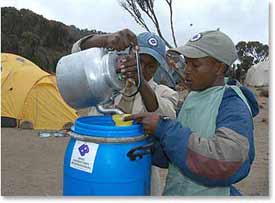
- 17. Do you have access to radio communications for any emergency needs if one were to arise?

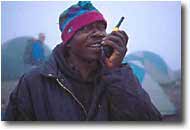
- We carry a cell phone and a radio on the mountain and safari. All our Kili trips are run in our normal, self-contained expedition style. Complete medical kits and the equipment necessary to deal with emergencies travels with us. The staff of 40 plus men who travel with each group of 6 to 8 are always ready for a possible emergency response. Our staff on the mountain stays in daily contact with both our Arusha office and our North American office, so if there should be an emergency message from your home it would get to you quickly.
- 18. Should I bring gifts for local Children?

- We find that a smile, genuine interest in people and a willingness to talk to them, perhaps some photographs of your family or postcards of where you live to be the greatest things to bring to share with the people of Tanzania. Tanzanians are generally poor, but very dignified and proud. We know parents in Tanzania who worry because they know that children will skip school to go stand along the roadsides and beg tourists for pencils or candy. You don’t have to worry, there are enough pencils and pens in the schools; the bigger problem is to get children to go to school and not become distracted by tourists who give things away.
- 19. What language is spoken in Tanzania?

- Tanzanians are proud that the vast cultural and ethnic diversity of their 130 tribes is unified under the national language, Swahili. English is the official second language of the country and is primary language of business and secondary education.
- 20. Why is the Pofu Route more expensive than the other routes on Kilimanjaro?

- The price difference is due to the remoteness of this route which poses unique challenges requiring additional staff and equipment as well as additional planning and coordination. We are really and truly on our own on this side of the mountain, making this a unique and exclusive way to experience Kilimanjaro, a Berg Adventures specialty not offered by any other company on the mountain.




